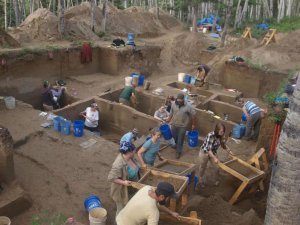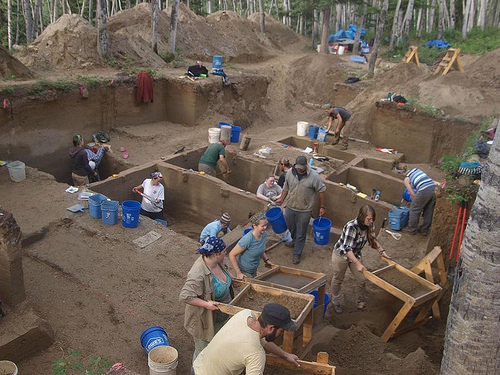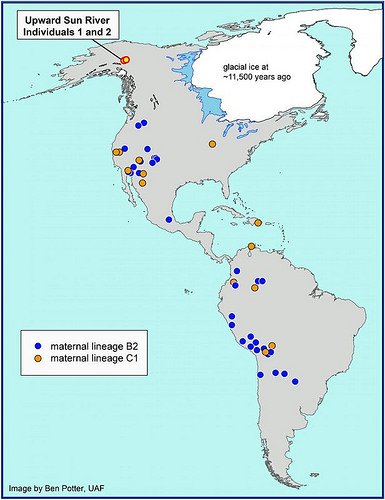
SALT LAKE CITY, Oct. 26, 2015 – University of Utah scientists deciphered maternal genetic material from two babies buried together at an Alaskan campsite 11,500 years ago. They found the infants had different mothers and were the northernmost known kin to two lineages of Native Americans found farther south throughout North and South America.
By showing that both genetic lineages lived so far north so long ago, the study supports the “Beringian standstill model.” It says that Native Americans descended from people who migrated from Asia to Beringia – the vast Bering land bridge that once linked Siberia and Alaska – and then spent up to 10,000 years in Beringia before moving rapidly into the Americas beginning at least 15,000 years ago.
“These infants are the earliest human remains in northern North America, and they carry distinctly Native American lineages,” says University of Utah anthropology professor Dennis O’Rourke, senior author of the paper set for online publication the week of Oct. 26 in the journal Proceedings of the National Academy of Sciences.
“We see diversity that is not present in modern Native American populations of the north and we see it at a fairly early date. This is evidence there was substantial genetic variation in the Beringian population before any of them moved south.”
___________________________________________
This is the Upward Sun River archaeological site in Alaska. Credit Ben Potter, University of Alaska Fairbanks
_____________________________________________
Another theory was that the two Native Americans lineages evolved as the people moved south and dispersed, not while they still were in Beringia, says Justin Tackney, the new study’s first author and a University of Utah anthropology doctoral student. But finding those lineages in the infants only a few thousand years after the migration south began indicates those lineages already were present before the migration started.
“It supports the Beringian standstill theory in that if they [the infants] represent a population that descended from the earlier Beringian population, it helps confirm the extent of genetic diversity in that source population,” O’Rourke says. “You don’t see any of these lineages that are distinctly Native American in Asia, even Siberia, so there had to be a period of isolation for these distinctive Native American lineages to have evolved away from their Asian ancestors. We believe that was in Beringia.”
The burial of ancient infants is rare. One was a 6- to 12-week-old baby; the other a stillborn or preterm 30-week fetus. The discovery of the infant burials first was reported in the same journal this past November. They are among human remains at only eight sites in North America older than 8,000 years and from which researchers obtained mitochondrial DNA – genetic information inherited only from mothers. The infants are the northernmost of all those remains and of the two lineages they represent.
In the eight sites, “we find all five of the major lineages of Native Americans,” Tackney says. “That indicates that all were present in the early population in Beringia that gave rise to all modern Native Americans.”
Sequencing DNA from the burials of Upward Sun River
The Upward Sun River ancient campsite was discovered in 2006 in the Tanana River valley about 50 miles southeast of Fairbanks. The area once was part of Beringia. The land bridge between Asia and Alaska existed when sea levels were low during the last Ice Age from 28,000 years ago to at least 18,000 years ago.
In 2010, a team led by University of Alaska Fairbanks anthropologist Ben Potter discovered the remains of a cremated 3-year-old child buried near the hearth of a residential structure. The child’s DNA couldn’t be recovered from the charred remains.
In 2013, Potter’s team found the remains of two more buried infants beneath the first. They had’t been cremated. Potter says it’s hard to tell how the infants died. Potter, who co-authored the new study, asked O’Rourke to analyze their mitochondrial DNA.
O’Rourke and Tackney worked with University of Utah geneticists to sequence the mitochondrial DNA of the two infants – known as USR1 and USR2 for Upward Sun River. Mitochondrial DNA is located in mitochondria, or the power plants of cells.
From fragments of skull bone, the researchers read 58.7 million DNA sequences from USR1 and 55.8 million from USR2. From those, the Utah scientists obtained 20,004 high-quality mitochondrial DNA sequences for USR1 and 32,979 for USR2.
“We were able to obtain the entire mitochondrial genome [genetic blueprint] sequence for each of them, as opposed to just a partial sequence,” O’Rourke says.
Infants related to two native lineages throughout the Americas
Potter says the new findings help in “understanding the genetic diversity among very early Beringian populations that connects them in many ways to Native Americans in both North and South America.”
The researchers identified infant USR1 as belonging to Native American lineage C1b, while infant USR2 is part of a more common native lineage known as B2. (Native American lineages begin with the letters A, B, C, D or X.)
“It’s not common to find infants buried together that are not related maternally,” O’Rourke says. “It raises questions about the social structure and mortuary practices of these early people,” including whether the babies had a common father.
Lineage C1 (most remains aren’t identified to the subgroup C1b level) is found most often among the Pima and Hualapai Indians of Arizona, the Delta Yuman of California, and six other tribes, including the Ignaciano in Bolivia, the extinct Tainos in Puerto Rico and a group represented by 700-year-old bones at Norris Farms in Illinois.
Lineage B2 is found most often in 37 tribes throughout the Americas, including the Yakama, Wishram, Northern Paiute-Shoshoni, Navajo, Hualapai (which also carries C1 genes), Zuni and Jemez in North America and the Quecha and Aymara in Peru. The B2 lineage also was common among the U.S. Southwest’s ancient Fremont and Anasazi.
The genetic data indicate that the most recent common ancestor of the C1b lineage existed at least 12,854 years ago, and the most recent common ancestor of the B2 lineage existed at least 12,024 years ago. O’Rourke suspects the real times were even earlier, but that nonetheless both 11,500-year-old infants were at or near the root of their respective genealogical trees.
“It may well be that the population represented by Upward Sun River is indicative of many such isolated populations distributed across Beringia, each of which may have contributed migrants to that early American Indian dispersal, and each may have been slightly genetically different from the others,” O’Rourke says.
_____________________________________________
This map shows the location of the Upward Sun River site in Alaska where the remains of two infants, Upward Sun River individuals 1 and 2, were found in an 11,500-year-old burial. A new University of Utah analysis shows the infants belong to two genetic groups or lineages known as B2 and C1. The maps shows other Native American groups throughout the Americas that are part of the same lineages. Credit Ben Potter, University of Alaska Fairbanks
_________________________________________________________________
Native lineages spread unevenly in the Americas
Modern tribal populations in northern North America show little mitochondrial DNA diversity, O’Rourke says. Why did lineages that once occupied the subarctic vanish there but show elsewhere in the Americas? And why aren’t the five major lineages spread evenly across the Americas?
“The reason is changes in population size and rates of population migration,” O’Rourke says. “In small populations, some lineages just get lost and don’t get passed on, and in others they become established and more common.”
“Studying the DNA of ancient individuals is important in researching how the Western Hemisphere was populated,” Tackney says. “Studying the genetics of these infants who died 11,500 years ago in what is now central Alaska helps answer questions of who these people were and how they are related to modern native populations.”
_________________________________________________________
The study was funded by the National Science Foundation and University of Utah, and supported by representatives of two native groups in the Upward Sun River area: the Healy Lake Tribal Council and Tanana Chiefs Conference.
O’Rourke, Tackney and Potter conducted the study with University of Utah senior lab specialists Michael Powers of the DNA sequencing core facility and W. Scott Watkins, in human genetics, and Derek Warner, sequencing facility director. Other co-authors were University of Kansas anthropologist Jennifer Raff, a former Utah postdoctoral fellow; archaeologist Joshua Reuther, of the University of Alaska Fairbanks; and bioarchaeologist Joel Irish, of Liverpool John Moores University.
_________________________________________________________
In addition, the latest Popular Archaeology ebook is now available.
______________________________________________
Travel and learn with Far Horizons.
____________________________________________
This richly illustrated issue includes the following stories: Two remarkable discoveries that are shedding light on human beginnings in Africa; a traveling exhibit and an archaeological site that show how knowledge is more valuable than gold; a Spanish cave and a unique burial that are offering a tantalizing glimpse on the lives of Ice Age hunter-gatherers in Europe; the stunning visual reconstruction of an ancient Roman town; enlightening new finds at a remarkably well-preserved site of ancient Hellenistic-Roman culture overlooking the Sea of Galilee; rare finds that are shedding light on occult practices among ancient Greeks in Sicily; and an overview of the overwhelmingly rich archaeological heritage of Britain. Find it on Amazon.com.











